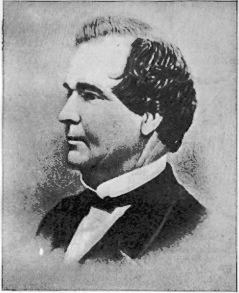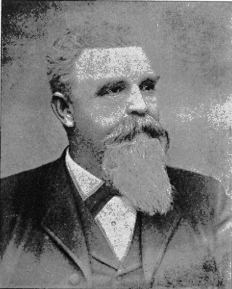
 OUR
miles from the Omaha Postoffice, in a broad valley admirably
adapted to the purpose, are located the Union Stock Yards,
which in 1884 was the nucleus about which has since grown
the suburban town of South Omaha, and where are now located
the big packing houses whose product OUR
miles from the Omaha Postoffice, in a broad valley admirably
adapted to the purpose, are located the Union Stock Yards,
which in 1884 was the nucleus about which has since grown
the suburban town of South Omaha, and where are now located
the big packing houses whose product
|
[It
is thirteen years since Edward Creighton died, and
that he is so well and honorably remembered in the
Omaha of to-day, aye his memory respected by the
thousands who have come here after he was no more,
but illustrates how great was his service to the
community, how broad and enduring a mark he made
upon his times. No one man did so much to sustain
Omaha in its early and trying days as Edward
Creighton. His career was a notable one in its
humble beginning and splendid triumph in the flush
of man-
|
|
hood. He was born in Belmont county, Ohio,
August 31, 1820, of Irish parentage. His early days
were passed upon a farm, but at the age of twenty
he took the contract for building part of the
National stage road from Wheeling, West Virginia,
to Springfield, Ohio. He continued in the
contracting business, but it was not until 1847
that he entered upon that branch of it in which he
achieved his greatest success and laid the
foundation of his after fortunes. In that year he
received the contract for and constructed a
telegraph line between Springfield and Cincinnati.
To this business he devoted his time and energies
for five years, being successfully engaged in the
construction of telegraph lines in all parts of the
country, completing the line from Cleveland to
Chicago in 1852. In 1856, while engaged in
telegraph construction in Missouri, Mr. Creighton
visited Omaha and his brothers, John A., James, and
Joseph, and his cousin James, locating here, he
returned to Ohio where he wedded Mary Lucretia
Wareham, of Dayton, and in 1857 himself came to
Omaha and located. He continued in the telegraph
construction business, completing in 1860 the first
line which gave Omaha
|

THE LATE EDWARD CREIGHTON.
|
connection with the outer world, via St. Louis.
For years Mr. Creighton had entertained a pet
project -- the building of a line to the Pacific
coast -- and in the winter of 1860 -- after many
conferences with the wealthy stockholders of the
Western Union company, a preliminary survey was
agreed upon. In those days the stage coach was the
only means of overland travel and that was beset
with great danger from Indians and road agents. In
the stage coach Mr. Creighton made his way to Salt
Lake City, where he enlisted the interest and
support of Brigham Young, the great head of the
Mormon church, in his project. It had been arranged
to associate the California State Telegraph Company
in the enterprise, and on to Sacramento in
midwinter Mr. Creighton pressed on horseback. It
was a terrible journey, but the man who made it was
of stout heart, and he braved the rigors of the
mountains and accomplished his mission, and in the
spring of 1861 Mr. Creighton returned to Omaha to
begin his great work. Congress had meanwhile
granted a subsidy of $40,000 a year for ten years
to the company which should build the line. Then a
great race was inaugurated for heavy wagers
|
|
between Mr. Creighton's construction force and
the California contractors who were building
eastward, to see which should reach Salt Lake City
first. Mr. Creighton had 1,100, miles to construct
and the Californians only 450, but Mr. Creighton
reached Salt Lake City on the seventeenth of
October, one week ahead of his competitors. On
October 24, but a little over six months after the
enterprise was begun, Mr. Creighton had established
telegraphic communication from ocean to ocean. He
had taken $100,000 of the stock of the new
enterprise at about eighteen cents on the dollar,
and when the project was completed the company
trebled its stock Mr. Creighton's $100,000 becoming
$300,000. The stock then rose to 85 cents and he
sold out $100,000 for $850,000, still retaining
$200,000 of the stock. He continued in the
telegraph construction business until 1867, his
great cattle interests in which he had embarked in
1864, and his great plains freighting business
established before the building of the Union
Pacific and continued even after its completion, to
the mining regions of Montana and Idaho, then
exacting his attention. During all these years of
great business success, Mr. Creighton was firm in
his allegiance to Omaha. He was the first president
of the First National Bank in the city and ever
ready to aid by his means and counsel any
enterprise for the furthering of Omaha's interests;
He commanded the confidence of all the people, his
sterling integrity and unwavering fidelity
combining with his generous and charitable nature
to make him a very lovable man. No man has an
unkind word to say of Edward Creighton and his
memory is revered to this day as an upright, just
and kind man who, out of his own sterling qualities
had wrought a successful and honorable career. He
was stricken with paralysis and died. November 5,
1874. To his memory, Creighton College was erected
and endowed by his relief in response to his own
wish, expressed during his life time, to found a
free institution for the non-sectarian education of
youth without regard to creed or sect -- the
institution only to be under Catholic
control.]
|
has given Omaha rank as the third city in the Union in meat
manufacture. In the year named, a number of local
capitalists who had interests in stock-raising, formed an
association for the purpose of building stock yards and
centralizing here the great cattle interests of the West.
They purchased a tract of 400 acres and built their stock
yards, and a glance at the enterprise to-day
shows
[117]
|


